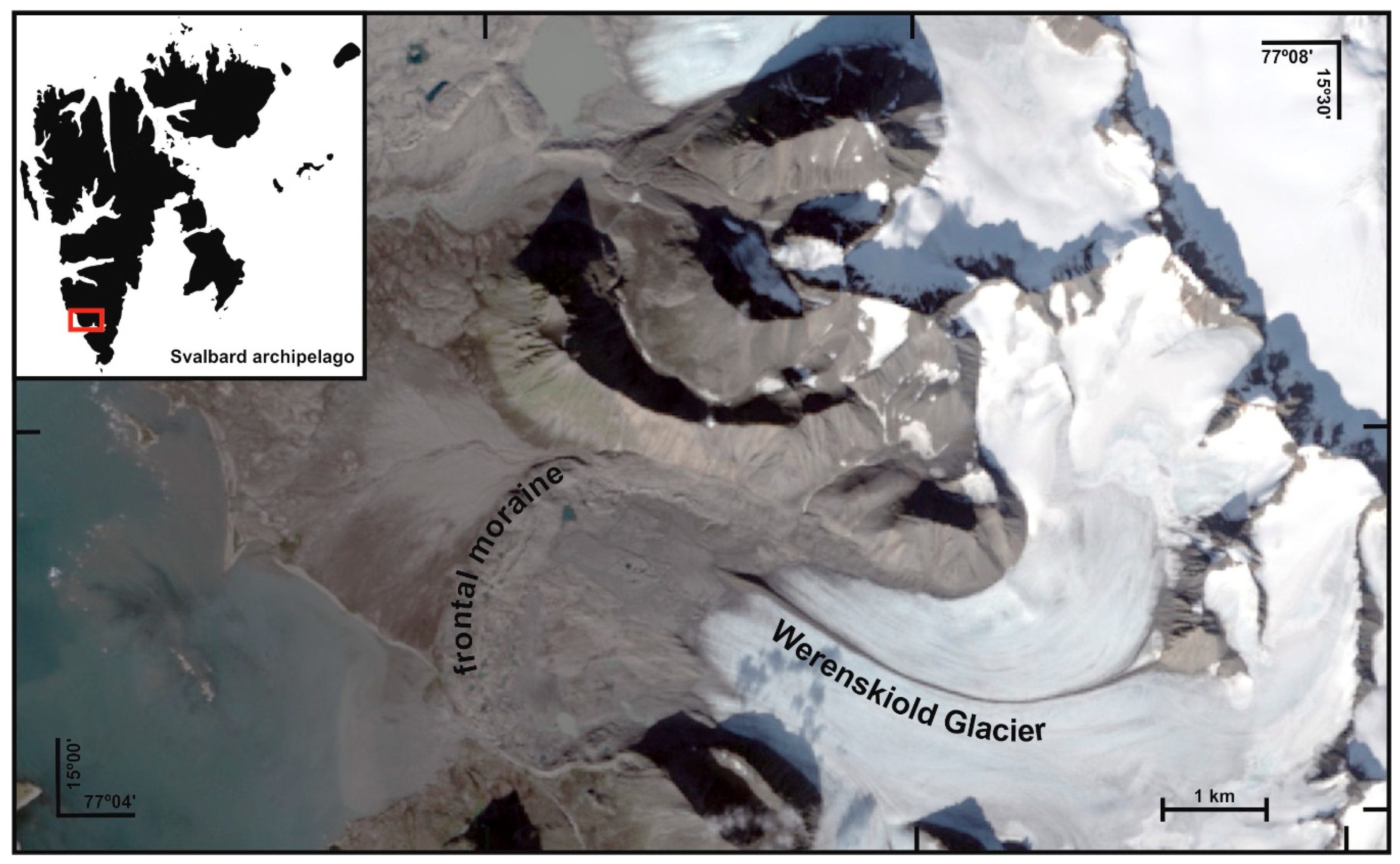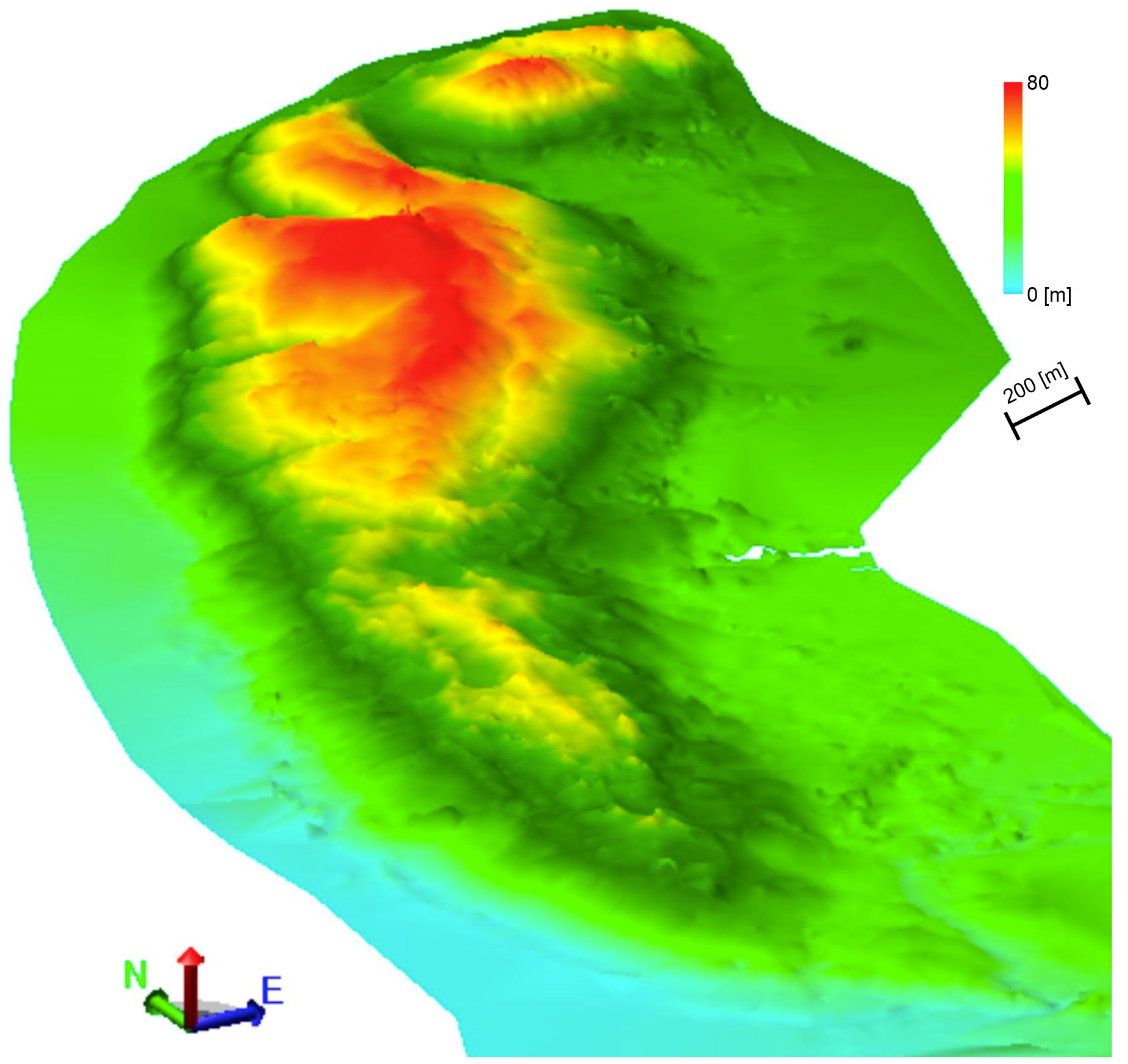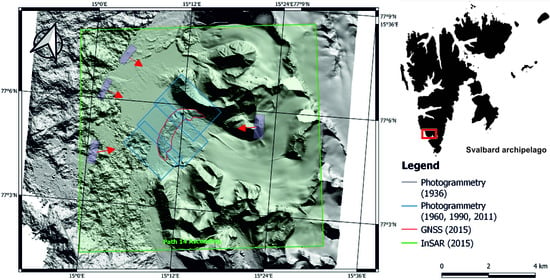Assessment of Morphology Changes of the End Moraine of the Werenskiold Glacier (SW Spitsbergen) Using Active and Passive Remote Sensing Techniques
Abstract
1. Introduction
2. Materials and Methods
3. Results
4. Discussion
4.1. Long-Term Analysis
4.2. Short-Term Analysis
4.3. Accuracy of the Results
5. Conclusions
Supplementary Materials
Author Contributions
Funding
Institutional Review Board Statement
Informed Consent Statement
Data Availability Statement
Conflicts of Interest
References
- Rignot, E.; Koppes, M.N.; Velicogna, I. Rapid submarine melting of the calving faces of West Greenland glaciers. Nat. Geosci. 2010, 3, 187–191. [Google Scholar] [CrossRef]
- Jenkins, A. Convection-Driven Melting near the Grounding Lines of Ice Shelves and Tidewater Glaciers. J. Phys. Oceanogr. 2011, 41, 2279–2294. [Google Scholar] [CrossRef]
- Motyka, R.J.; Dryer, W.P.; Amundson, J.; Truffer, M.; Fahnestock, M. Rapid submarine melting driven by subglacial dis-charge, LeConte Glacier, Alaska. Geophys. Res. Lett. 2013, 40, 5153–5158. [Google Scholar] [CrossRef]
- Carey, M. In the Shadow of Melting Glaciers: Climate Change and Andean Society; Oxford University Press: Oxford, UK, 2010. [Google Scholar]
- Milillo, P.; Rignot, E.; Rizzoli, P.; Scheuchl, B.; Mouginot, J.; Bueso-Bello, J.; Prats-Iraola, P. Heterogeneous retreat and ice melt of Thwaites Glacier, West Antarctica. Sci. Adv. 2019, 5, eaau3433. [Google Scholar] [CrossRef]
- Smith, J.A.; Graham, A.G.C.; Post, A.L.; Hillenbrand, C.-D.; Bart, P.J.; Powell, R.D. The marine geological imprint of Antarctic ice shelves. Nat. Commun. 2019, 10, 1–16. [Google Scholar] [CrossRef] [PubMed]
- Rignot, E.J. Fast Recession of a West Antarctic Glacier. Science 1998, 281, 549–551. [Google Scholar] [CrossRef] [PubMed]
- Rignot, E.; Jacobs, S.; Mouginot, J.; Scheuchl, B. Ice-Shelf Melting Around Antarctica. Science 2013, 341, 266–270. [Google Scholar] [CrossRef]
- Dowdeswell, J.A.; Hagen, J.O.; Björnsson, H.; Glazovsky, A.F.; Harrison, W.D.; Holmlund, P.; Jania, J.; Koerner, R.M.; Lefauconnier, B.; Ommanney, C.S.L.; et al. The Mass Balance of Circum-Arctic Glaciers and Recent Climate Change. Quat. Res. 1997, 48, 1–14. [Google Scholar] [CrossRef]
- Jania, E.; Hagen, E. Mass Balance of Arctic Glaciers; University of Silesia, Faculty of Earth Sciences: Katowice, Poland, 1996. [Google Scholar]
- Gardner, A.S.; Moholdt, G.; Wouters, B.; Wolken, G.J.; Burgess, D.O.; Sharp, M.J.; Cogley, J.G.; Braun, C.; Labine, C. Sharply increased mass loss from glaciers and ice caps in the Canadian Arctic Archipelago. Nature 2011, 473, 357–360. [Google Scholar] [CrossRef]
- Steiner, D.; Pauling, A.; Nussbaumer, S.U.; Nesje, A.; Luterbacher, J.; Wanner, H.; Zumbühl, H.J. Sensitivity of European glaciers to precipitation and temperature—Two case studies. Clim. Chang. 2008, 90, 413–441. [Google Scholar] [CrossRef]
- Haeberli, W.; Noelle, M. Application of inventory data for estimating characteristics of and regional climate-change effects on mountain glaciers: A pilot study with the European Alps. Ann. Glaciol. 1995, 21, 206–212. [Google Scholar] [CrossRef]
- Vincent, C.; Fischer, A.; Mayer, C.; Bauder, A.; Galos, S.P.; Funk, M.; Thibert, E.; Six, D.; Braun, L.; Huss, M. Common climatic signal from glaciers in the European Alps over the last 50 years. Geophys. Res. Lett. 2017, 44, 1376–1383. [Google Scholar] [CrossRef]
- Bolch, T.; Kulkarni, A.; Kääb, A.; Huggel, C.; Paul, F.; Cogley, J.G.; Frey, H.; Kargel, J.S.; Fujita, K.; Scheel, M.; et al. The State and Fate of Himalayan Glaciers. Science 2012, 336, 310–314. [Google Scholar] [CrossRef]
- Fujita, K.; Nuimura, T. Spatially heterogeneous wastage of Himalayan glaciers. Proc. Natl. Acad. Sci. USA 2011, 108, 14011–14014. [Google Scholar] [CrossRef] [PubMed]
- Bolch, T.; Pieczonka, T.; Benn, D.I. Multi-decadal mass loss of glaciers in the Everest area (Nepal Himalaya) derived from stereo imagery. Cryosphere 2011, 5, 349–358. [Google Scholar] [CrossRef]
- Kulkarni, A.V.; Karyakarte, Y. Observed changes in Himalayan glaciers. Curr. Sci. 2014, 106, 237–244. [Google Scholar]
- Davies, B.; Glasser, N. Accelerating shrinkage of Patagonian glaciers from the Little Ice Age (~AD 1870) to 2011. J. Glaciol. 2012, 58, 1063–1084. [Google Scholar] [CrossRef]
- Mark, B.G.; French, A.; Baraer, M.; Carey, M.; Bury, J.; Young, K.R.; Polk, M.H.; Wigmore, O.; Lagos, P.; Crumley, R.; et al. Glacier loss and hydro-social risks in the Peruvian Andes. Glob. Planet. Chang. 2017, 159, 61–76. [Google Scholar] [CrossRef]
- Braun, M.H.; Malz, P.; Sommer, C.; Farías-Barahona, D.; Sauter, T.; Casassa, G.; Soruco, A.; Skvarca, P.; Seehaus, T.C. Constraining glacier elevation and mass changes in South America. Nat. Clim. Chang. 2019, 9, 130–136. [Google Scholar] [CrossRef]
- Cullen, N.J.; Mölg, T.; Kaser, G.; Hussein, K.; Steffen, K.; Hardy, D.R. Kilimanjaro Glaciers: Recent areal extent from satellite data and new interpretation of observed 20th century retreat rates. Geophys. Res. Lett. 2006, 33. [Google Scholar] [CrossRef]
- Moelg, T.; Cullen, N.J.; Hardy, D.R.; Kaser, G.; Nicholson, L.; Prinz, R.; Winkler, M. East African glacier loss and climate change: Corrections to the UNEP article “Africa without ice and snow”. Environ. Dev. 2013, 6, 1–6. [Google Scholar] [CrossRef]
- Prinz, R.; Heller, A.; Ladner, M.; Nicholson, L.I.; Kaser, G. Mapping the Loss of Mt. Kenya’s Glaciers: An Example of the Challenges of Satellite Monitoring of Very Small Glaciers. Geosciences 2018, 8, 174. [Google Scholar] [CrossRef]
- Cisek, M.; Makuch, P.; Petelski, T. Comparison of meteorological conditions in Svalbard fjords: Hornsund and Kongsfjorden. Oceanologia 2017, 59, 413–421. [Google Scholar] [CrossRef]
- Adakudlu, M.; Andersen, J.; Bakke, J.; Beldring, S.; Benestad, R.; Bilt, W.V.; Bogen, J.; Borstad, C.; Breili, K.; Breivik, Ø.; et al. Climate in Svalbard 2100. A Knowledge Base for Climate Adaptation; Norwegian Centre for Climate Services (NCCS): Trondheim, Norway, 2019. [Google Scholar]
- Zwoliński, Z.; Giżejewski, J.; Karczewski, A.; Kasprzak, M.; Lankauf, K.R.; Migoń, P.; Zagórski, P. Geomorphological settings of Polish research areas on Spitsbergen. Landf. Anal. 2013, 22, 125–143. [Google Scholar] [CrossRef]
- Tonkin, T.; Midgley, N.; Cook, S.; Graham, D. Ice-cored moraine degradation mapped and quantified using an unmanned aerial vehicle: A case study from a polythermal glacier in Svalbard. Geomorphology 2016, 258, 1–10. [Google Scholar] [CrossRef]
- Fox, A.J.; Nuttall, A.M. Photogrammetry as A Research Tool for Glaciology. Photogramm. Rec. 1997, 15, 725–737. [Google Scholar] [CrossRef]
- Eiken, T.; Sund, M. Photogrammetric methods applied to Svalbard glaciers: Accuracies and challenges. Polar Res. 2012, 31, 18671. [Google Scholar] [CrossRef]
- Vincent, C.; Wagnon, P.; Shea, J.M.; Immerzeel, W.W.; Kraaijenbrink, P.; Shrestha, D.; Soruco, A.; Arnaud, Y.; Brun, F.; Berthier, E.; et al. Reduced melt on debris-covered glaciers: Investigations from Changri Nup Glacier, Nepal. Cryosphere 2016, 10, 1845–1858. [Google Scholar] [CrossRef]
- Gindraux, S.; Boesch, R.; Farinotti, D. Accuracy Assessment of Digital Surface Models from Unmanned Aerial Vehicles’ Imagery on Glaciers. Remote. Sens. 2017, 9, 186. [Google Scholar] [CrossRef]
- Bindschadler, R.A.; Jezek, K.C.; Crawford, J. Glaciological investigations using the synthetic aperture radar imaging system. Annals Glaciol. 1987, 9, 11–19. [Google Scholar] [CrossRef]
- Rao, Y.S. Synthetic Aperture Radar (SAR) Interferometry for Glacier Movement Studies. Encyclopedia of Snow, Ice and Glaciers; Springer: Dordrecht, The Netherlands, 2011; pp. 1133–1142. [Google Scholar]
- Sharov, A.I.; Osokin, S.A. Controlled interferometric models of glacier changes in south Svalbard. In Proceedings of the Fringe 2005 Workshop, Frascati, Italy, 28 November 2006; pp. 321–365. [Google Scholar]
- Zhou, X.; Chang, N.B.; Li, S. Applications of SAR interferometry in earth and environmental science research. Sensors 2009, 9, 1876–1912. [Google Scholar] [CrossRef]
- Schneevoigt, N.J.; Sund, M.; Bogren, W.; Kääb, A.; Weydahl, D.J. Glacier displacement on Comfortlessbreen, Svalbard, using 2-pass differential SAR interferometry (DInSAR) with a digital elevation model. Polar Rec. 2011, 48, 17–25. [Google Scholar] [CrossRef]
- Liu, G.; Fan, J.H.; Zhao, F.; Mao, K.B. Monitoring elevation change of glaciers on Geladandong Mountain using TanDEM-X SAR interferometry. J. Mt. Sci. 2017, 14, 859–869. [Google Scholar] [CrossRef]
- Rouyet, L.; Lauknes, T.R.; Christiansen, H.H.; Strand, S.M.; Larsen, Y. Seasonal dynamics of a permafrost landscape, Adventdalen, Svalbard, investigated by InSAR. Remote. Sens. Environ. 2019, 231, 111236. [Google Scholar] [CrossRef]
- Johansson, A.M.; Malnes, E.; Gerland, S.; Cristea, A.; Doulgeris, A.P.; Divine, D.V.; Lauknes, T.R. Consistent ice and open water classification combining historical synthetic aperture radar satellite images from ERS-1/2, Envisat ASAR, RA-DARSAT-2 and Sentinel-1A/B. Ann. Glaciol. 2020, 61, 40–50. [Google Scholar] [CrossRef]
- Samsonov, S.; Tiampo, K.; Cassotto, R. Measuring the state and temporal evolution of glaciers using SAR-derived 3D time series of glacier surface flow. Cryosphere Discuss. 2020, 1–21. [Google Scholar] [CrossRef]
- Sommer, C.; Malz, P.; Seehaus, T.C.; Lippl, S.; Zemp, M.; Braun, M.H. Rapid glacier retreat and downwasting throughout the European Alps in the early 21st century. Nat. Commun. 2020, 11, 1–10. [Google Scholar] [CrossRef] [PubMed]
- Ferretti, A.; Prati, C.; Rocca, F. Permanent scatterers in SAR interferometry. IEEE Trans. Geosci. Remote. Sens. 2001, 39, 8–20. [Google Scholar] [CrossRef]
- Berardino, P.; Fornaro, G.; Lanari, R.; Sansosti, E. A new algorithm for surface deformation monitoring based on small baseline differential SAR interferograms. IEEE Trans. Geosci. Remote. Sens. 2002, 40, 2375–2383. [Google Scholar] [CrossRef]
- Hooper, A.; Zebker, H.; Segall, P.; Kampes, B. A new method for measuring deformation on volcanoes and other natural terrains using InSAR persistent scatterers. Geophys. Res. Lett. 2004, 31. [Google Scholar] [CrossRef]
- Interactive Topographic Map of Svalbard Archipelago. Available online: https://toposvalbard.npolar.no/ (accessed on 3 November 2020).
- Official Website of The Norwegian Polar Institute. Available online: https://www.npolar.no/ (accessed on 10 September 2015).
- Ebmeier, S.; Biggs, J.; Mather, T.; Elliott, J.; Wadge, G.; Amelung, F. Measuring large topographic change with InSAR: Lava thicknesses, extrusion rate and subsidence rate at Santiaguito volcano, Guatemala. Earth Planet. Sci. Lett. 2012, 335–336, 216–225. [Google Scholar] [CrossRef]
- Schlögel, R.; Doubre, C.; Malet, J.-P.; Masson, F. Landslide deformation monitoring with ALOS/PALSAR imagery: A D-InSAR geomorphological interpretation method. Geomorphology 2015, 231, 314–330. [Google Scholar] [CrossRef]
- Di Traglia, F.; Nolesini, T.; Ciampalini, A.; Solari, L.; Frodella, W.; Bellotti, F.; Fumagalli, A.; De Rosa, G.; Casagli, N. Tracking morphological changes and slope instability using spaceborne and ground-based SAR data. Geomorphology 2018, 300, 95–112. [Google Scholar] [CrossRef]
- Sandwell, D.T.; Mellors, R.J.; Tong, X.; Wei, M.; Wessel, P. Open radar interferometry software for mapping surface Deformation. EOS 2011, 92, 234. [Google Scholar] [CrossRef]
- Strozzi, T.; Antonova, S.; Günther, F.; Mätzler, E.; Vieira, G.; Wegmüller, U.; Westermann, S.; Bartsch, A. Sentinel-1 SAR inter-ferometry for surface deformation monitoring in low-land permafrost areas. Remote Sens. 2018, 10, 1360. [Google Scholar] [CrossRef]
- Goldstein, R.M.; Werner, C.L. Radar interferogram filtering for geophysical applications. Geophys. Res. Lett. 1998, 25, 4035–4038. [Google Scholar] [CrossRef]
- Baran, I.; Stewart, M.; Kampes, B.; Perski, Z.; Lilly, P. A modification to the Goldstein radar interferogram filter. IEEE Trans. Geosci. Remote. Sens. 2003, 41, 2114–2118. [Google Scholar] [CrossRef]
- Cavalié, O.; Doin, M.-P.; Lasserre, C.; Briole, P. Ground motion measurement in the Lake Mead area, Nevada, by differential synthetic aperture radar interferometry time series analysis: Probing the lithosphere rheological structure. J. Geophys. Res. Space Phys. 2007, 112. [Google Scholar] [CrossRef]
- Chen, C.; Zebker, H. Phase unwrapping for large SAR interferograms: Statistical segmentation and generalized network models. IEEE Trans. Geosci. Remote. Sens. 2002, 40, 1709–1719. [Google Scholar] [CrossRef]
- Tymofyeyeva, E.; Fialko, Y.A. Mitigation of atmospheric phase delays in InSAR data, with application to the eastern California shear zone. J. Geophys. Res. Solid Earth 2015, 120, 5952–5963. [Google Scholar] [CrossRef]
- Lyons, S.; Sandwell, D. Fault creep along the southern San Andreas from interferometric synthetic aperture radar, permanent scatterers, and stacking. J. Geophys. Res. Space Phys. 2003, 108. [Google Scholar] [CrossRef]
- Peltzer, G.; Crampé, F.; Hensley, S.; Rosen, P. Transient strain accumulation and fault interaction in the Eastern California shear zone. Geology 2001, 29, 975–978. [Google Scholar] [CrossRef]
- Lauknes, T.R.; Zebker, H.A.; Larsen, Y. InSAR Deformation Time Series Using an L1-Norm Small-Baseline Approach. IEEE Trans. Geosci. Remote Sens. 2010, 49, 536–546. [Google Scholar] [CrossRef]
- Bennett, M.R.; Huddart, D.; Hambrey, M.J.; Ghienne, J.F. Moraine development at the high-arctic valley glacier Pedersenbreen, Svalbard. Geogr. Ann. Ser. A Phys. Geogr. 1996, 78, 209–222. [Google Scholar] [CrossRef]








| Type/Year of Measurement Session | Number of Pictures | Type | Color | Number of Points |
|---|---|---|---|---|
| photogrammetric/1936 | 7 | oblique imagery | black and white | 759 |
| photogrammetric/1960 | 3 | orthoimage | black and white | 1645 |
| photogrammetric/1990 | 3 | orthoimage | color | 5072 |
| photogrammetric/2011 | 6 | orthoimage | color | 3922 * |
| Model Data | Volume Loss | Volume Increase | Volume Difference [Absolute Value] | Total Difference |
|---|---|---|---|---|
| [m3] | ||||
| 1936 * | - | - | - | - |
| 1960 | 4,600,000 | 220,000 | 4,380,000 | 4,380,000 |
| 1990 | 8,690,000 | 4,170,000 | 4,520,000 | 8,900,000 |
| 2011 | 1,300,000 | 4,500,000 | 3,200,000 | 12,100,000 |
| 2015 | 2,505,587 | 139,386 | 2,066,201 | 14,166,201 |
| Model Number (Data of Exposition) | Volume Loss | Volume Increase | Volume Difference [Absolute Value] | Total Difference |
|---|---|---|---|---|
| [m3] | ||||
| 2015/08/02 * | - | - | - | - |
| 2015/08/14 | 49,500.5 | 1540.6 | 47,960.0 | 47,960.0 |
| 2015/08/26 | 13,168.9 | 11,388.4 | 1780.5 | 49,740.5 |
| 2015/09/07 | 85,869.8 | 0.6 | 85,869.2 | 135,609.7 |
| 2015/09/19 | 10,550.4 | 7856.8 | 2693.6 | 138,303.3 |
| 2015/10/01 | 21,535.4 | 6293.9 | 15,241.5 | 153,544.8 |
| 2015/10/13 | 226.3 | 49,165.1 | 48,938.8 | 202,483.6 |
| 2015/10/25 | 23,769.2 | 1393.8 | 22,375.4 | 224,859.0 |
| 2015/11/06 | 684.3 | 29,267.1 | 28,582.8 | 253,441.8 |
Publisher’s Note: MDPI stays neutral with regard to jurisdictional claims in published maps and institutional affiliations. |
© 2021 by the authors. Licensee MDPI, Basel, Switzerland. This article is an open access article distributed under the terms and conditions of the Creative Commons Attribution (CC BY) license (https://creativecommons.org/licenses/by/4.0/).
Share and Cite
Głowacki, T.; Kasza, D. Assessment of Morphology Changes of the End Moraine of the Werenskiold Glacier (SW Spitsbergen) Using Active and Passive Remote Sensing Techniques. Remote Sens. 2021, 13, 2134. https://doi.org/10.3390/rs13112134
Głowacki T, Kasza D. Assessment of Morphology Changes of the End Moraine of the Werenskiold Glacier (SW Spitsbergen) Using Active and Passive Remote Sensing Techniques. Remote Sensing. 2021; 13(11):2134. https://doi.org/10.3390/rs13112134
Chicago/Turabian StyleGłowacki, Tadeusz, and Damian Kasza. 2021. "Assessment of Morphology Changes of the End Moraine of the Werenskiold Glacier (SW Spitsbergen) Using Active and Passive Remote Sensing Techniques" Remote Sensing 13, no. 11: 2134. https://doi.org/10.3390/rs13112134
APA StyleGłowacki, T., & Kasza, D. (2021). Assessment of Morphology Changes of the End Moraine of the Werenskiold Glacier (SW Spitsbergen) Using Active and Passive Remote Sensing Techniques. Remote Sensing, 13(11), 2134. https://doi.org/10.3390/rs13112134








